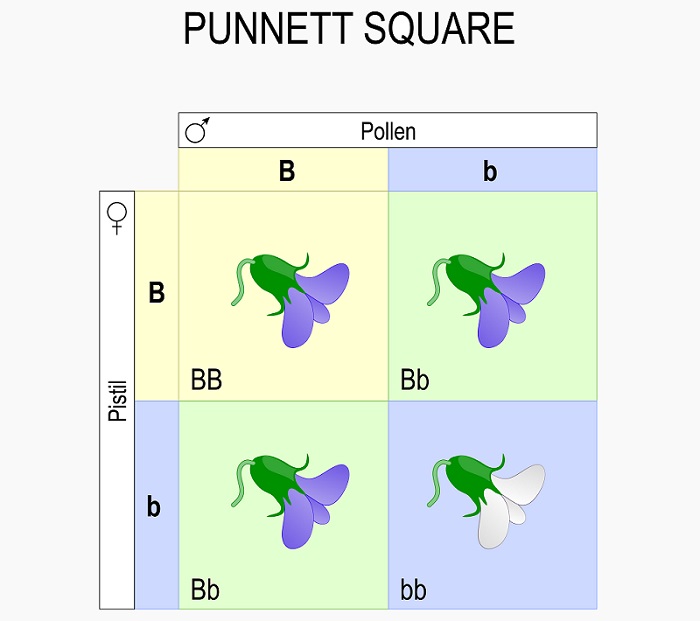[LS3-1] DNA and Chromosomes in Inheritance
This standard focuses on how DNA and chromosomes function to transfer traits from parents to offspring.
Resources for this Standard:
Here’s the Actual Standard:
Ask questions to clarify relationships about the role of DNA and chromosomes in coding the instructions for characteristic traits passed from parents to offspring.
Standard Breakdown
First, let’s look at the concepts behind this standard, then review some ways to encourage students to investigate the process of inheritance.
Inheritance
Since the days of Gregor Mendel (circa 1850), there has been clear evidence that organisms inherit traits from their parents. Mendel, a monk and the original genetics nerd, studied the different traits of pea plants, and how these traits were passed on. Mendel found that for a number of traits there appeared to be multiple, distinct versions of each trait – what we now call alleles. Mendel also noticed that some alleles showed dominance over other alleles, like in the image below

However, we have come a long way since Mendel’s pea plant experiments. We now understand the exact genetic mechanisms behind Mendel’s Laws.
DNA
Starting from the bottom up, DNA creates proteins. Proteins create different functions within cells. This leads to measurable traits – everything from eye color to height (or flower color in plants).
The alleles that Mendel noticed are actually genetic variations within the DNA. Though humans share 99.9% of the DNA sequence between two individuals, the 0.1% of small nucleotide changes, deletions, and insertions in the DNA code can completely change the function of almost every protein. Sometimes these changes can be dramatic – such as the complete lack of protein function seen in many recessive traits. Other times, a change in protein function simply slow or speed a reaction crucial to the formation of particular traits.
Inheritance through DNA
A zygote is formed when one gamete fertilizes the other (sperm and egg cells, in many organisms). Each gamete cell carries one copy of the DNA code to form a diploid cell – you have two copies of 23 chromosomes, in each cell of your body.
To create gametes, sexually reproducing organisms use the process of meiosis, seen below (and covered further in other standards).

During meiosis, several things can happen that contribute to the variation of alleles within a population. First, new mutations in the DNA can occur during DNA replication or because of a mutagen from the environment. If these mutations are in a line of cells that produces gametes, the mutations can be passed on to offspring. Further, through the process of meiosis genes for various traits are randomly distributed to gametes and chromosomes can be rearranged. This increases the variation of organisms because it recombines alleles from maternal and paternal lines into new combinations.
Investigating Inheritance
There are many great ways to help students investigate the process of inheritance, and plenty of animal and plant photos online for students to do their own genetics investigations. Some basic genetic tools can help greatly in the process. The Punnett square is likely the most useful tool, as seen below.

Punnett squares can be used in many ways, such as predicting the offspring on a certain parental cross or estimating the alleles present in a population. There is a wide variety of traits that have been well-documented in fruit flies and pea plants, though students can also be encouraged to investigate almost any organism they want to understand the genetic inheritance patterns for this standard.
What to Avoid
This NGSS standard also contains the following Assessment Boundary:
Assessment does not include the phases of meiosis or the biochemical mechanism of specific steps in the process.:
Let’s look at these two boundaries in more detail:
Phases of Meiosis:
Analyzing and modeling the phases of mitosis is not necessary (for this standard). Instead, students should be assessed on the bigger concepts surrounding the role of meiosis in inheritance. Because the chromosomes are mixed up and some crossing-over occurs, meiosis creates Mendel’s Law of Segregation and Law of Independent Assortment. Mendel’s Law of Dominance is a function of protein function and the fact that a single functional copy often works well enough to create a trait (such as purple flowers)
Biochemical Mechanisms:
In this context, the “biochemical mechanism” refers to both how specific steps in meiosis take place, and how specific alleles create a certain trait variant.
For example, the purple-flower allele in pea plants is actually a gene that produces a protein crucial to the production of purple pigment molecules. Since one functional allele produces enough purple pigment, the “purple allele” is considered dominant to the “white allele”, which requires two non-functional alleles and is considered recessive. Anything more biochemical than this, such as the actual reaction the protein affects or how the protein actually functions is beyond the scope of this standard.
